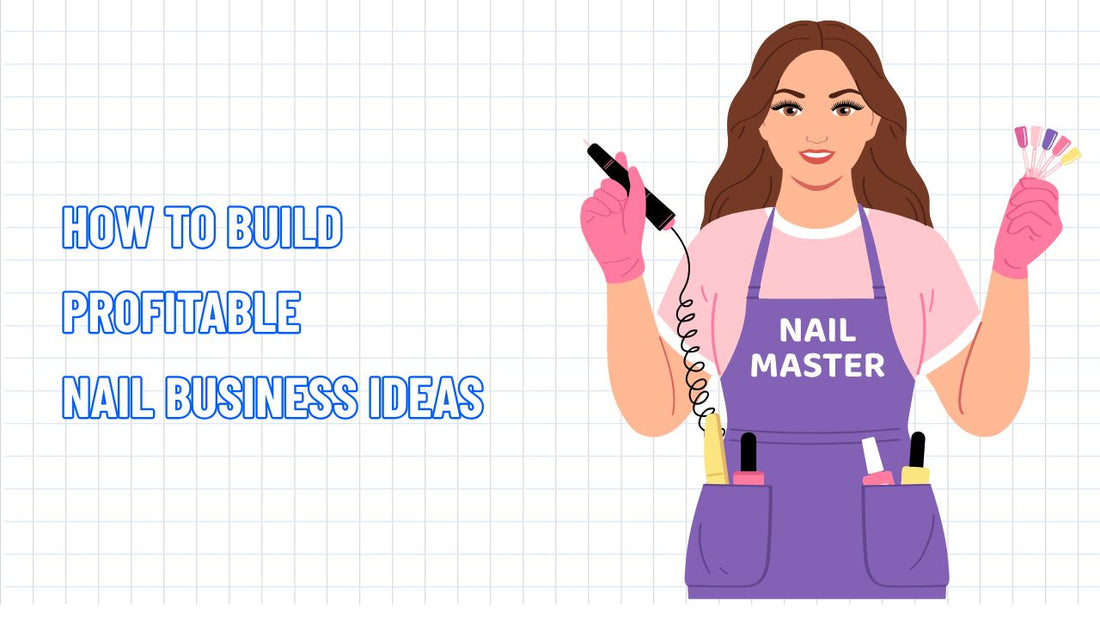How to Build Profitable Nail Business Ideas in 2025
Table of Contents Hide
Starting a nail business is an inspiring journey to turn your passion into a profitable enterprise. In this article, NextSky provides a detailed roadmap and in-depth strategies to help your brand grow sustainably and achieve remarkable success.
What is a nail business?
A nail business provides hand and foot care and beauty services, including nail polish application, gel manicures, acrylic extensions, dip powder, and nail art. These services are typically offered at professional nail salons but can also be provided in personal studios or at home with a compact setup.

Standard services in a nail salon
A professional nail salon typically offers diverse services to meet clients' growing aesthetic demands. Some notable services include:
- Manicure: Cleaning, shaping, cuticle care, nail buffing, and a gentle hand massage.
- Pedicure: Similar to a manicure but for feet, often including exfoliation, moisturizing, and a relaxing massage.
- Gel nails: Applying gel polish cured under UV/LED lights for a glossy, long-lasting, chip-free finish.
- Dip powder: Coating nails with colored powder and a protective layer for durability and a natural shine.
- Acrylic nails: Artificial nails can be created using a liquid monomer and acrylic powder for customizable length and shape.
- Nail art: Hand-painted designs, rhinestone embellishments, glitter, or decals for a personalized touch.
- Spa services: Many salons offer relaxing treatments like herbal foot soaks, masks, exfoliation, or aromatherapy massages.
Additionally, nail salons often sell retail products like nail polish, tools, and hand creams, creating a steady secondary revenue stream.
See more: Top 26 Best Online Business Ideas in 2025 Worth Trying Today
Step-by-step guide to starting a nail business
Obtain certifications and licenses

Before offering nail services, you'll need appropriate certifications and licenses, which vary by state and country. Common requirements include:
- Nail technician certification: Complete a state-approved nail or cosmetology training program (e.g., 400 hours in California or 240 hours in New York), covering manicures, pedicures, nail art, sanitation, and safety.
- Licensing exam: Pass theoretical and practical exams administered by the state cosmetology board.
- Business license: Register your business with local authorities and obtain an Employer Identification Number (EIN) if hiring staff.
- Home studio regulations: If operating from home, check zoning laws and ensure a separate client entrance in some states (e.g., California).
Expert tip: Visit your state's cosmetology board website for specific requirements. For home studios, confirm if you can operate without a local license, though most states require one for safety and professionalism.
See more: Do You Need a Business License to Sell on Shopify
Conduct market research
Understanding the market is critical for positioning your nail business for success. Thorough research helps identify your target audience, competitors, and unique opportunities.
- Demographic analysis: Study the age, income, and preferences of potential clients in your area. Are they seeking affordable nail care or premium designs?
- Competitor analysis: Explore local nail salons and their online presence (websites, social media) to assess pricing, services, ambiance, and customer feedback. Identify unmet market needs.
-
Niche selection: Differentiate with a unique selling proposition (USP), such as:
- Eco-friendly salons using non-toxic, vegan polishes.
- Luxury spa experiences with aromatherapy and massage chairs.
- Custom press-on nail designs for exclusivity.
- Mobile nail services for convenience.
Action step: Use tools like Google Trends or social media analytics to track popular nail trends (e.g., minimalist designs, chrome effects) and tailor your services accordingly.
Choose a business model

Selecting the right business model directly impacts operations and cost management. Common models include:
- Nail salon: A fixed location with a team of technicians, ideal for high-traffic areas.
- Home studio: Cost-effective, bypassing rent, but must comply with local regulations and maintain sanitation.
- Mobile services: Bringing services to clients for convenience and differentiation.
- Press-on nail business: Designing and selling nails online, ideal for low-cost startups with scalability.
Create a detailed nail business plan
A clear business plan guides growth and is essential for securing loans or investors. Include the following:
- Executive summary: Briefly outline your vision, mission, and goals for the nail salon.
- Market analysis: Detail customer needs, competitors, and your target audience.
-
Services and pricing: List offerings like manicures, gel nails, or nail art, with competitive pricing based on costs and market rates. For example:
- Basic manicure: $20–$35
- Gel nails: $30–$45
- Nail art: $5–$15 per nail
- Marketing strategy: Explain how you'll attract and retain clients, such as through social media, local partnerships, or loyalty programs.
- Financial projections: Estimate startup costs (equipment, supplies, rent), monthly operating expenses, and expected revenue, with a 6–12-month contingency budget.
- Operational plan: Describe your business structure (sole proprietorship, LLC, etc.), staffing needs, and daily operations.
Tip: Use templates from Shopify or SCORE to streamline planning and ensure no critical sections are missed.
See more: How to Create a Winning Dropshipping Business Plan
Register and choose a business structure

Registering your business ensures legal operation and builds a strong foundation for your brand. Choosing the proper legal structure protects personal assets, optimizes taxes, and supports long-term growth:
- Sole proprietorship: Easy to set up with low costs, but no separation of personal assets.
- LLC: Flexible, protects personal assets, ideal for salons with employees.
- Corporation: Suitable for large-scale operations or those seeking expansion or investment.
Steps to take:
- Check and register your business name, ensuring domain availability for a website.
- Register with local authorities and obtain an EIN from the IRS if hiring staff.
- Secure the necessary licenses, such as cosmetology or health permits, depending on your state.
- Purchase general liability insurance to protect against risks like accidents, allergies, or service disputes.
Fund and manage startup costs
Starting a nail business requires initial investment in equipment, supplies, space, and licenses. Common costs include:
- Equipment: Nail tables ($100–$500 each), UV/LED lamps ($50–$200), electric files ($100–$300), and ventilation systems ($200–$1,000).
- Supplies: Nail polish, gel, acrylic, nail art tools, disinfectants, and disposable items like gloves and towels.
- Space: Salon rent ($1,000–$5,000/month, depending on location) or home studio setup ($500–$2,000).
- Licenses and insurance: Approximately $500–$2,000 for business licenses and basic insurance.
- Marketing: Professional website ($0–$1,000 using platforms like Shopify) and social media ads ($100–$500/month).
Funding sources:
- Personal savings or loans from family and friends.
- SBA or commercial bank loans.
- Crowdfunding or local investor partnerships.
Invest in high-quality equipment and supplies
High-quality equipment and supplies ensure a professional experience and client satisfaction. Prioritize durable products to minimize replacement costs and maintain consistent performance.
-
Essential equipment:
- Ergonomic nail tables and chairs for technician and client comfort.
- High-performance UV/LED lamps for efficient gel curing.
- Electric files for quick, low-vibration shaping and removal.
- Ventilation systems to reduce chemical odors and improve air quality.
- Sterilization equipment, such as autoclaves or UV sanitizers, for hygiene.
-
Key supplies:
- Diverse nail polish colors, from nudes to neons.
- Gel and acrylic for durable nails and extensions.
- Nail art tools like brushes, rhinestones, and decals.
- Sanitation products like gloves, disinfectants, and wipes.
- Cuticle care tools and oils.
Action tips:
- Manage inventory tightly to avoid shortages or overstocking.
- Consider vegan or eco-friendly products to appeal to sustainability-conscious clients.
Design a welcoming space
Your salon's ambiance is where clients seek relaxation and a complete beauty experience. Whether a commercial salon or home studio, create a clean, cozy, and professional environment.
- Efficient layout: Arrange workstations to maximize space, ensure easy movement, and meet sanitation regulations.
- Comfortable furniture: Invest in ergonomic chairs and sturdy nail tables. Massage chairs for pedicures enhance the experience.
- Ideal lighting: Use white or natural light for accurate work and explicit photos of nail designs.
- Relaxing atmosphere: Add scented candles, essential oil diffusers, or soft music, keeping chemicals safely stored.
- Brand identity: Choose colors, towels, and decor that align with your logo and style, from soft pastels to sleek black-and-white.
Set up efficient booking and payment systems
A smooth operational system saves time and enhances the client experience.
- Booking system: Use platforms like Booksy, Square Appointments, or Shopify's booking integration for easy scheduling. Send automated reminders via email or text to reduce no-shows.
- Payment system: This system accepts multiple methods, such as credit cards, cash, Venmo, and PayPal. Use Shopify Payments for secure in-person and online transactions.
- Inventory management: Track supplies with software like Square or spreadsheets to ensure popular items like gel polish or nail art stones are always in stock.
Tip: Offer bundled services (e.g., manicure + pedicure discounts) or loyalty cards (e.g., buy 5, get 1 free) to encourage repeat visits.
Market your nail business effectively

Effective marketing attracts clients and builds a strong brand. Combine online and offline strategies for a competitive edge:
- Professional website: Use NextSky's Shopify themes like Glozin or Umino for an SEO-optimized site with integrated booking, service menus, and product galleries.
- Social media engagement: Share stunning nail designs, before-and-after photos, and behind-the-scenes videos on Instagram, TikTok, and Pinterest. Boost interaction with contests, giveaways, or mini-games.
- Local connections: Join industry events, partner with local businesses, or offer referral discounts to expand your client base.
- Innovative promotions: Use grand opening deals or Groupon offers to attract initial clients, a strategy that helped Daisy Kalnina's salon quickly build a steady clientele.
- Unique experience: Leverage NextSky's e-commerce solutions to streamline booking and enhance client convenience.
With strategic marketing, your nail business can stand out and sustain growth in a competitive market.
Win clients with exceptional service
Outstanding service turns first-time clients into loyal advocates. Focus on these elements for a memorable experience:
- Personalization: Suggest nail styles, colors, or designs based on clients' lifestyles or special occasions. For example, elegant nudes for office workers or glittery nail art for parties.
- Strict hygiene: Adhere to rigorous sanitation standards, sterilizing tools after each use, using disposable items, and maintaining a clean, professional space.
- Continuous learning: Stay updated on trends like ombre, chrome, or minimalist designs through courses or workshops. Train staff regularly for consistent quality.
- Heartfelt care: Create a relaxing atmosphere with soft music, small drinks, and friendly service. A genuine smile and attentive listening often leave the strongest impression.
Tip: Offer new clients a simple complimentary service, like a hand massage or cuticle oil application, to create a lasting impression and encourage return visits.
Starting a nail business is a fantastic opportunity to blend creativity, entrepreneurship, and client care. With this comprehensive guide from NextSky, you can build a professional online presence to attract and retain clients. Your nail business can shine in this thriving industry with dedication and strategic planning.










